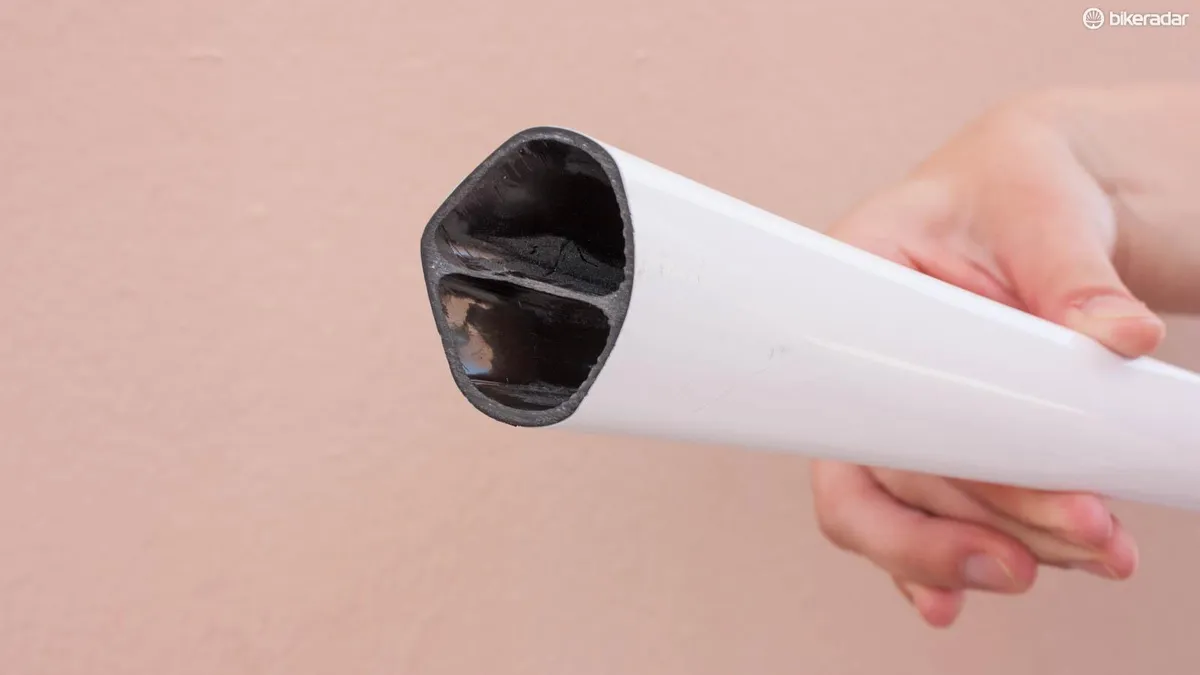While aero superbikes have dominated headlines of late, the weight-weenie wars have continued unabated. The latest contender to enter the ring is Fuji, which just launched an all-new machine called the SL under the slogan “Worth the Weight”. The new bike takes over from the Altamira as the company’s flagship climbing platform. It’s making its pro race debut at the 2015 Vuelta a Espana, with four members of the Caja Rural-Suguros RGA team set to ride it.

The headline figure for the new bike is 695g – that’s how much a size 56cm frame weighs before 45g of hardware and paint are added, and the top-of-the range SL 1.1 claims to tip the scales at an amazing 4.95kg / 10.91lb. Bear in mind that under current rules, that puts it 1.85kg below the minimum weight allowed in the pro peloton. (Although we’re assuming the figure doesn’t include pedals, which admittedly narrow the gap a little.)



The Fuji SL 1.1
Carbon wizardry
The SL’s frame is manufactured using a process introduced with the Altamira in 2013 called “High Compaction” moulding, which combines internal and external moulds to produce a product that’s as finished on the inside as it is on the outside. This avoids the unnecessary addition of weight, and distributes resin more evenly during manufacturing, producing the strongest possible frame.

The inside of the SL's downtube is unusually smoothCarbon frames are usually made of sub-assemblies, and the Altimira had a total of eight bonded joints in its construction. Thanks to an improved manufacturing process, the SL halves that number, with seatstays and chainstays that are made up of a single hollow piece on each side. Since joints add significant weight, this was one of the major areas in which savings were made.

Fewer bonded joints mean less weightIt almost goes without saying that Fuji has upped the stiffness with the new model, and we’d be failing in our journalistic duty if we didn’t tell you that the SL is a claimed 9% stiffer in the headtube, 11% stiffer in the bottom bracket, and 18% stiffer in the fork than its predecessor. That last number is the result of what Fuji calls a 'Reinforced I-Beam' design for the fork which appropriately enough, consists of a central reinforcing rib running the length of the legs.

The SL's fork is ribbed for your... stiffnessFor once, no quantitative claims have been made about improvements to comfort, but Fuji does note that the new bike features skinny, oval cross-section seatstays much like those of the Altamira. It's also got a sensible 27.2mm seatpost, so there's a decent chance it won't disappoint in this respect.
The devil in the details
You don’t design a new bike for the pros without paying some attention to the finer details. Like many manufacturers, Fuji recognises the need to vary carbon layups across the size range to accommodate different rider weights (also Focus’ Stable Stiffness Per Size), but they go further and actually vary tube diameters too. The handling has received similar attention, with the smallest three sizes getting a different fork offset (52mm instead of 43mm) to the larger ones, which maintains an almost consistent trail figure for all but the tiny XXS size.
On a practical note, the frame includes a boss to mount a chain catcher, while a chainstay protector stands guard in the event of chain-suck. Naturally, the frame will take both electronic and mechanical groupsets, with neat injection-moulded cable stops keeping things tidy. Under the bottom bracket, the mechanical cable guide can be swapped for a smooth cover to give your bike the full Ken-doll if you switch from mechanical to electronic.

Pricing and availability
The SL will go on sale in October, with pricing as follows:SL 1.1 SRAM Red 22, Reynolds RZR 46 wheelset: £8,499 / $9,999 / €11,999

SL 1.3 Shimano Dura Ace Di2: $6,320 (US model only)





SL 1.5 Shimano Dura Ace: £3,399 / $4,740 / €4,799





SL 1.1 frameset: $1,900 / €1,799





If the pro-level 1-series is too rich for your blood, fear not - Fuji will offer a slightly heavier version of the frame in a range of builds called the 2-series, as follows:SL 2.1 Shimano Ultegra Di2: £2,599 / $3,690 / €3,799

SL 2.3 Shimano Ultegra: £1,599 / $2,240 / €2,299




SL 2.5 Shimano 105: £1,499 / $2,000 / €1,999




SL Team Replica (2-series) Shimano 105: £TBC / $N/A / €2,599















